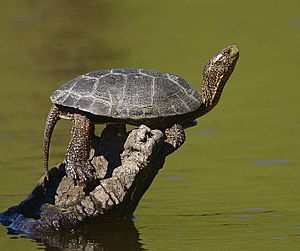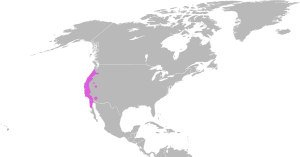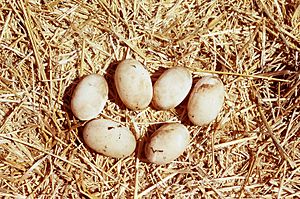Western pond turtle facts for kids
The Western Pond Turtle (Actinemys marmorata), also called the Pacific pond turtle, is a small to medium-sized turtle. It belongs to the Emydidae family. This turtle lives only along the western coast of the United States and Mexico. Its home ranges from western Washington state down to northern Baja California. The Western Pond Turtle used to live in Canada. But in 2002, it was listed as "extirpated" there. This means it no longer exists in Canada.
Quick facts for kids Western pond turtle |
|
|---|---|
 |
|
| Conservation status | |
| Scientific classification | |
 |
|
| The range of the western pond turtle. | |
| Synonyms | |
Contents
What is a Western Pond Turtle?
The Western Pond Turtle has a dark brown or dull olive shell. Sometimes, it has darker patterns or streaks. The bottom part of its shell, called the plastron, is yellowish. It might have dark spots in the middle of its plates.
The top shell, or carapace, is about 11 to 21 centimeters (4 to 8 inches) long. It is low and wide, and it feels smooth. Adult turtles show sexual dimorphism. This means males and females look a bit different. Male turtles have a light or pale yellow throat.
Where Do Western Pond Turtles Live?
Western Pond Turtles originally lived from northern Baja California, Mexico, up to the Puget Sound area in Washington. They were once a big part of a fishing industry in California. People used them for turtle soup.
Today, these turtles are rare or gone from the Puget Sound area. They are also found in scattered groups in the Northwest. Some small groups live in southern Washington. The turtles are rare in the Willamette Valley north of Eugene, Oregon. But they are more common south of that city, where it is warmer. You might find them in some streams, rivers, and ponds in southern Oregon.
A few turtles have been seen east of the Cascade Mountains. But these might be turtles that were brought there by people. They live up to 305 meters (1,000 feet) high in Washington. In Oregon, they can live up to 915 meters (3,000 feet) high. They also live in the Uvas Canyon area in California. You can find them in the North Bay and lakes like Fountaingrove Lake.
Scientists now think there are two types of Western Pond Turtles. The southern type is called Actinemys pallida. It lives in southern California and Mexico. The northern type is still called Actinemys marmorata. It lives from northern California northward. This northern type is often called the northwestern pond turtle.
How Western Pond Turtles Live
Western Pond Turtles live in both waters that are always there and waters that dry up. This includes marshes, streams, rivers, ponds, and lakes. They like places with many logs or big rocks. They gather on these to warm up in the sun. They also bask on top of water plants.
It can be hard to spot these turtles in the wild. But if you move slowly and hide behind plants, you might see them. Scientists can also use special floating platforms, called rafts, to help find the turtles. The turtles like to use these rafts to bask.
Land is also very important for these turtles. Many ponds can dry up in summer and fall, especially when there is little rain. During these times, Western Pond Turtles can spend up to 200 days out of the water. Many turtles also spend the winter out of the water. This is often when they build their nests.
What Do Western Pond Turtles Eat?
The Western Pond Turtle is an omnivore. This means it eats both plants and animals. Most of its animal diet includes insects, crayfish, and other small water creatures. Sometimes, they eat fish, tadpoles, and frogs. They will also eat dead animals if they find them.
For plants, they eat stringy algae, lily pads, and the roots of plants like tule and cattail. Young turtles mostly eat meat. They eat insects and dead animals. When they are about three years old, they start to eat plants too.
Who Are Their Predators?
The Western Pond Turtle has a hard shell, which usually protects it well. But some animals do hunt these turtles. This is especially true for baby turtles, called hatchlings. They are small and have soft shells.
Raccoons, otters, ospreys, and coyotes are the biggest natural threats to adult turtles. Baby turtles also face dangers from weasels, bullfrogs, non-native crayfish, and large fish.
People also threaten these turtles. Because of habitat destruction, the Western Pond Turtle is listed as "vulnerable" on the IUCN Red List. This means it is at risk of becoming extinct. Ponds and wetlands are being removed, and water sources are getting polluted. Efforts are being made to help these turtles by bringing them back to their native homes.
Reproduction and Life Cycle
Female Western Pond Turtles that are old enough to have babies lay 5 to 13 eggs at a time. They lay eggs once or twice a year. They might travel far from the water to lay their eggs. They can go as far as 0.8 kilometers (half a mile) away. They might also go up to 90 meters (300 feet) higher than the nearest water. But most nests are within 90 meters (300 feet) of water.
The female turtle usually leaves the water in the evening. She might wander around a lot before choosing a nest spot. She often picks an open area of sand or hard dirt that faces south. The nest is shaped like a flask, with an opening about 5 centimeters (2 inches) wide. Females spend a lot of time covering the nest with soil and nearby plants. This makes it hard for people to find, unless an animal has dug it up.
Hatchlings
Most Western Pond Turtle hatchlings stay in their nest over the winter. This happens in most parts of their range, especially in northern areas. This might be why it is hard for scientists to find baby turtles in the fall. Winter rains might be needed to soften the hard dirt where some nests are. The nest might be the safest place for the babies to stay until warm weather returns.
Whether it's eggs or baby turtles that stay over winter, young turtles usually appear in the spring. This is the spring after the eggs were laid. Turtles grow slowly in the wild. In the northern areas, they might be 10 to 12 years old before they can have their own babies. A Western Pond Turtle can live for more than 50 years in the wild.
Images for kids
See also
 In Spanish: Galápago occidental para niños
In Spanish: Galápago occidental para niños




